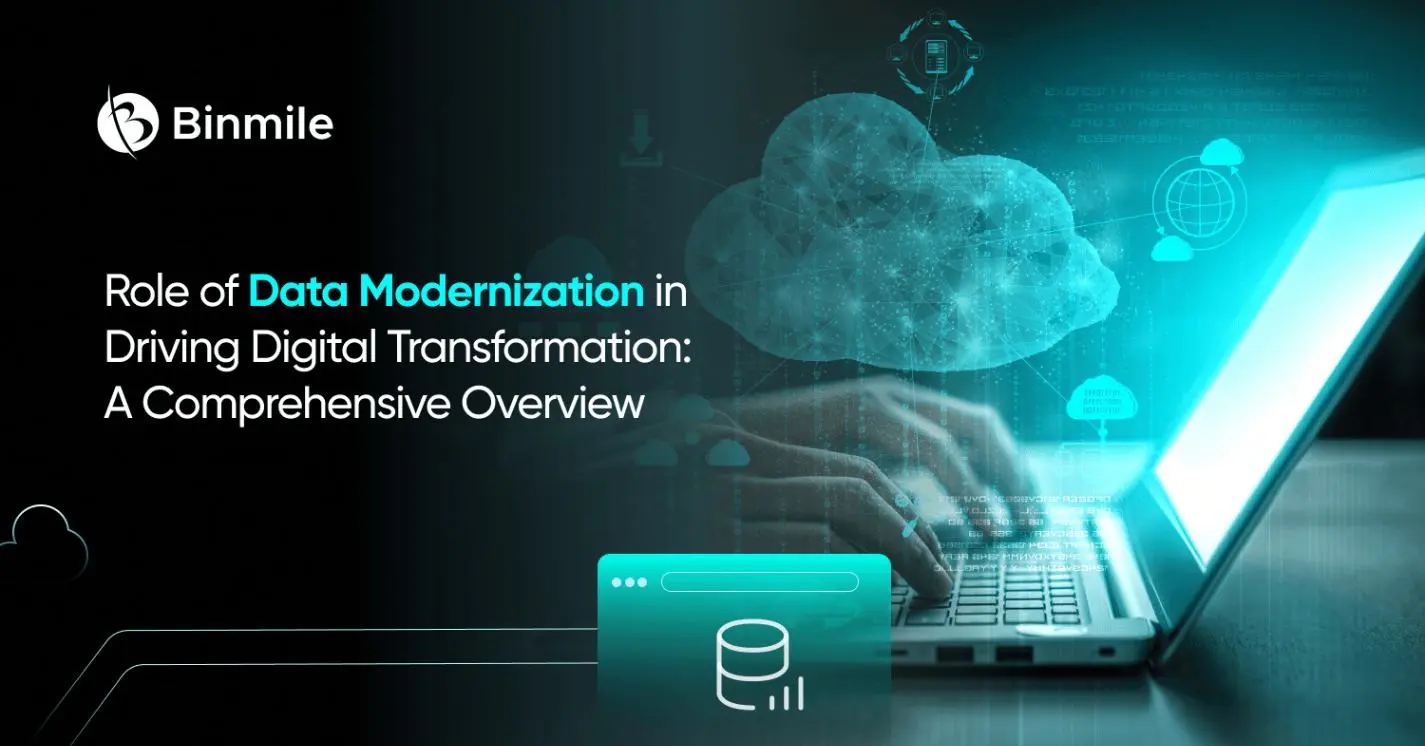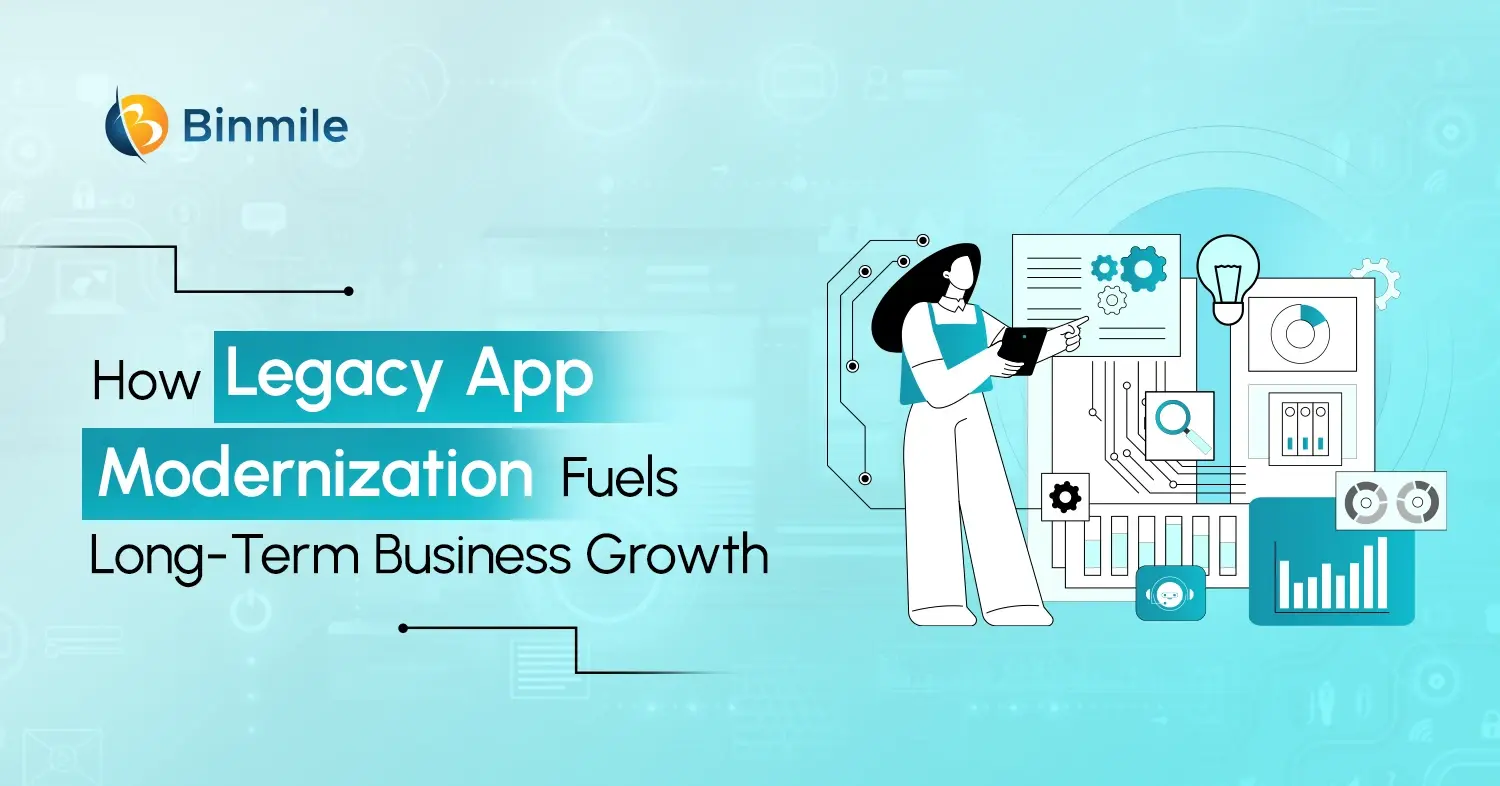Do you know every day 2.5 quintillions of data are being created? Imagine what this exorbitant amount of data can do for your business if utilized smartly. That’s the reason, data has emerged as the currency that fuels business growth and innovation. Organizations no longer focus on keeping the business running. They need to keep the focus more on moving forward with the next generation of IT solutions. Enters data modernization services – a process that empowers businesses to leverage the powers of data.
As businesses increasingly recognize the transformative potential of data, data modernization becomes an imperative rather than an option. After all, the ability to harness data’s power can make the difference between stagnation and growth, relevance and obsolescence. So, how can businesses redefine their data strategies? How can they position themselves to thrive in the digital age? What are the ways they can be one of the thriving data modernization companies in their respective industries?
This blog will discuss these questions, additionally, we’ll look into what are data modernization concepts, and some tips to create a data-first modernization and its components. We’ll also talk about why it’s important to digital transformation.
What is Data Modernization: An Introduction
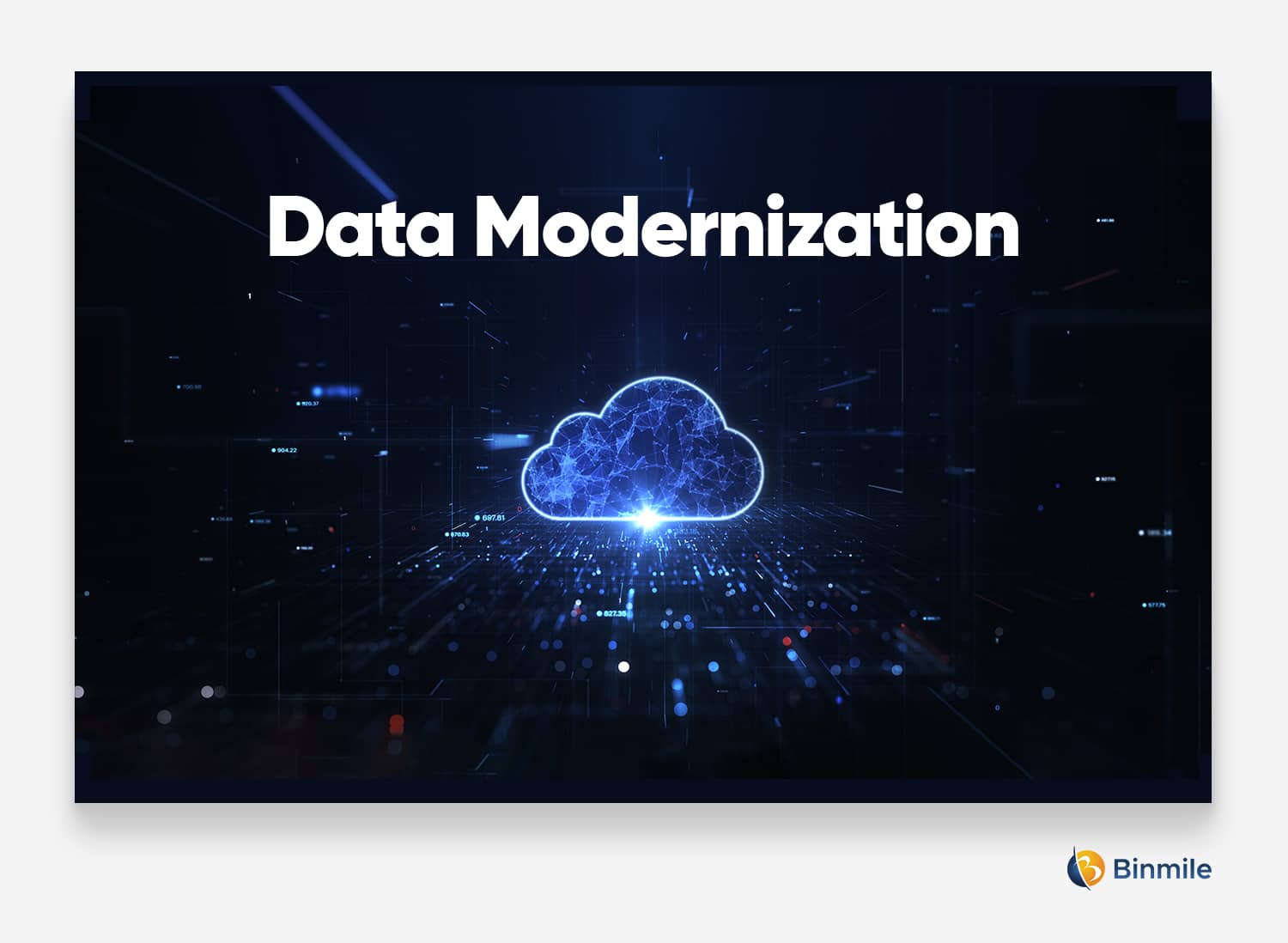
It is more than just a technology upgrade; it’s a comprehensive strategy that encompasses the entire data lifecycle–from collection and storage to processing and analysis. It refers to the process of upgrading and optimizing data infrastructure, technologies, and practices to meet the demands of modern business requirements. Data modernization services include a range of solutions and strategies aimed at upgrading and optimizing an organization’s data infrastructure, processes, and practices. These services are designed to enhance data management, analytics, and utilization, helping businesses unlock the full potential of their data. Here are some common database modernization services:
- Data Integration and Migration
- Cloud Migration Services
- Data Quality Management
- Advanced Analytics and AI Integration
- Data Governance and Compliance
- Data Architecture Design:
- Real-time Data Processing
- Data Visualization and Reporting
- Legacy System Modernization
This modernization journey is supported by several key pillars:
Strategic Pillars for Navigating Modernization in Business
- Data Integration and Accessibility: Siloed data inhibits informed decision-making. Modernizing data infrastructure involves integrating data from disparate sources, making it easily accessible to stakeholders across the organization. This democratization of data leads to faster insights and better collaboration.
- Scalability and Flexibility: Traditional data infrastructures often struggle to cope with the increasing volume, velocity, and variety of data. Modernization involves transitioning to cloud-based solutions that offer unparalleled scalability, ensuring that businesses can handle data growth without compromising performance.
- Real-time Processing: In today’s fast-paced business landscape, the ability to process and analyze data in real time is crucial. Modern data platforms allow businesses to make decisions based on the most up-to-date information, leading to improved responsiveness and agility.
- Advanced Analytics and AI: Database modernization services set the stage for advanced analytics and AI applications. By leveraging machine learning and AI algorithms on modern data platforms, businesses can uncover valuable insights, automate processes, and predict future trends with higher accuracy.
- Data Security and Compliance: As data becomes more valuable, securing it becomes paramount. Modern data platforms offer robust security features and compliance frameworks, safeguarding sensitive information and ensuring adherence to regulations.
Integration with Cloud: How Cloud Technologies Elevate Database Modernization Services
Data modernization services and cloud technologies are tightly intertwined, driving businesses towards more agile, scalable, and data-driven operations. With the help of application modernization services, organizations can achieve several benefits, such as:
- Cloud platforms offer virtually limitless storage, enabling businesses to handle massive volumes of data.
- Real-time data processing and analytics become feasible, empowering quick decision-making.
- With the scalability of cloud resources, digital transformation in businesses can adapt to data growth without significant infrastructure investments.
- Cloud providers offer robust security features and compliance certifications, enhancing data protection.
Therefore, data modernization services powered by cloud technologies enable businesses to harness data’s transformative powers, driving innovation, efficiency, and competitiveness in an increasingly data-driven world.
Transform your database modernization with seamless cloud integration - partner with us today.
Why Data Modernization Services is the Key For Digital Transformation: 7 Reasons to Know
Once businesses understand the transformative impact of data modernization on their operations it’ll help them leverage data to drive positive change across multiple aspects of their operations and strategies. So, let’s explore its advantages:
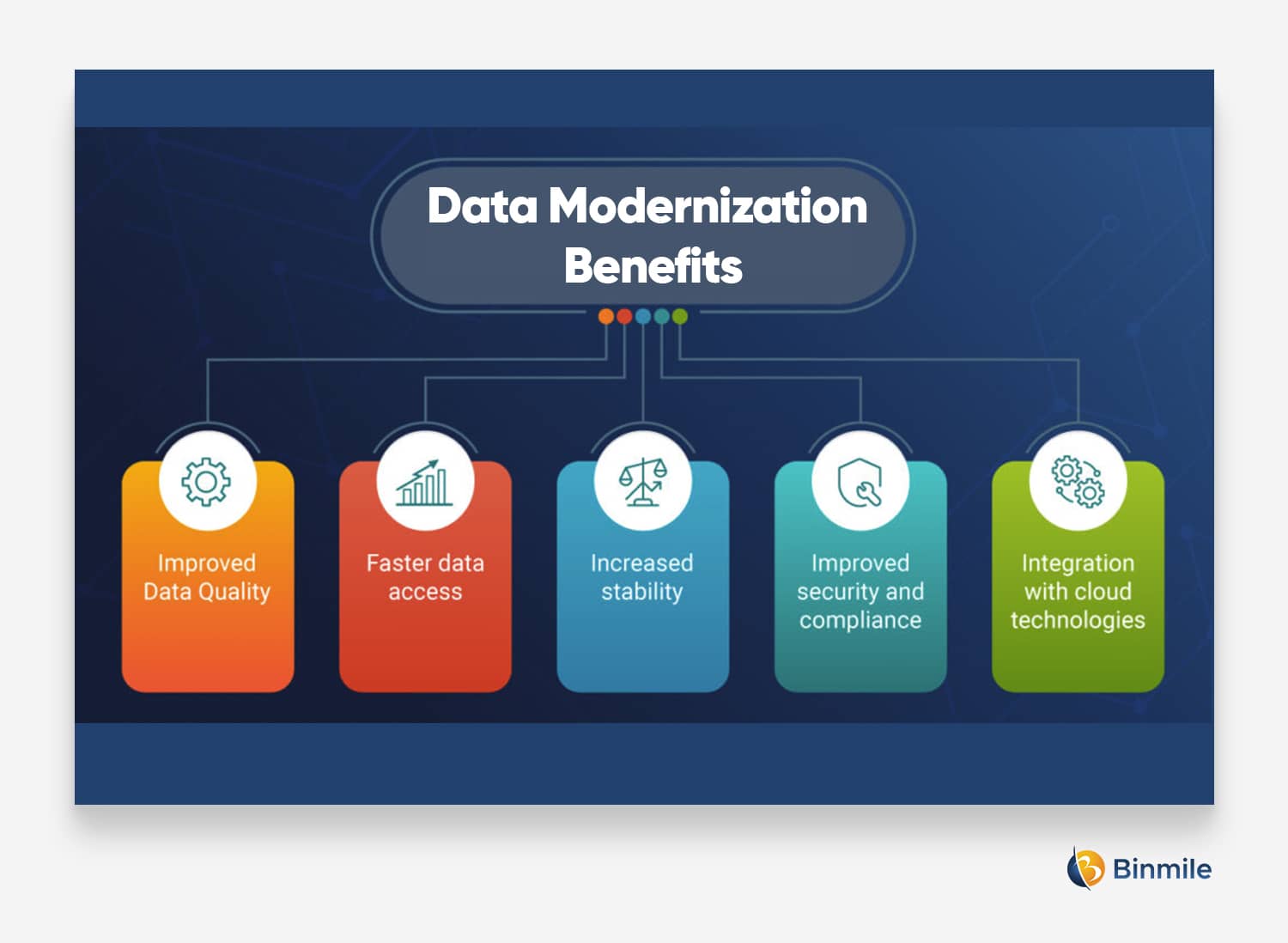
1. Data-Driven Decision-Making
Data modernization marks a shift from intuition-based decisions to those grounded in data-backed insights. Businesses are leveraging modernized data platforms to collect and analyze real-time data from various sources. This information fuels informed decision-making, as leaders can now assess market trends, customer preferences, and operational performance in depth. This empowers organizations to be more proactive, agile, and responsive to changing business dynamics.
2. Personalized Customer Experiences
It is revolutionizing how businesses interact with their customers. By harnessing the power of application modernization services, companies can create a 360-degree view of each customer’s journey. This comprehensive understanding enables businesses to tailor their products, services, and communications to individual preferences. Whether it’s personalized product recommendations, targeted marketing campaigns, or customized support interactions, businesses can enhance customer satisfaction by delivering experiences that resonate on a personal level.
3. Enhanced Operational Efficiency
Modernizing data processes brings significant operational benefits. Data-driven insights enable businesses to pinpoint operational inefficiencies, optimize resource allocation, and streamline workflows. For instance, manufacturers can use real-time sensor data to track equipment performance and implement predictive maintenance strategies, reducing downtime and minimizing disruptions. Such optimizations lead to cost savings, improved productivity, and a more effective allocation of resources.
4. Advanced Security and Compliance
Modern data platforms and transforming businesses access to advanced security features and robust compliance frameworks against data breaches, unauthorized access, and cyber threats. Security measures like implementing encryption, access controls, and audit trails to ensure the confidentiality, integrity, and availability of sensitive information. Moreover, compliance with industry-specific standards and compliances becomes more manageable through automated monitoring and reporting mechanisms. Thus, modernized data systems empower businesses to safeguard data assets, build customer trust, and avoid potential legal and reputational risks.
5. Faster Data Accessibility
Database modernization empowers businesses to harness the power of data swiftly and efficiently. This significantly reduces query response times and improves overall system performance. Modernized databases leverage advanced indexing, caching mechanisms, and efficient data storage methods to ensure quick and seamless data retrieval. As a result, enhanced speed in data access enables employees to make informed decisions faster, boost customer experiences by delivering real-time information, and support agile business operations.
6. Increased Agile Growth & Innovation
Traditional business models often struggle to adapt swiftly to evolving market trends. Data modernization strategy, however, facilitates agility in innovation. By leveraging real-time data analytics and insights, businesses can prototype, test, and refine new ideas rapidly. This iterative approach enables quicker product development cycles, reducing time-to-market for innovative offerings. Organizations can experiment with new features, business models, and market strategies, gaining a competitive edge through their ability to innovate at speed.
7. Improved Predictive Analytics
The power of predictive analytics is a hallmark of data modernization. Businesses are now able to anticipate future trends and outcomes by analyzing historical and real-time data. This capability empowers organizations to make proactive decisions, such as adjusting supply chain logistics based on demand forecasts or mitigating potential risks by identifying anomalies in data patterns. The ability to foresee trends allows businesses to stay ahead of the curve and make well-informed strategic choices.
How to Get Started With Database Modernization Services
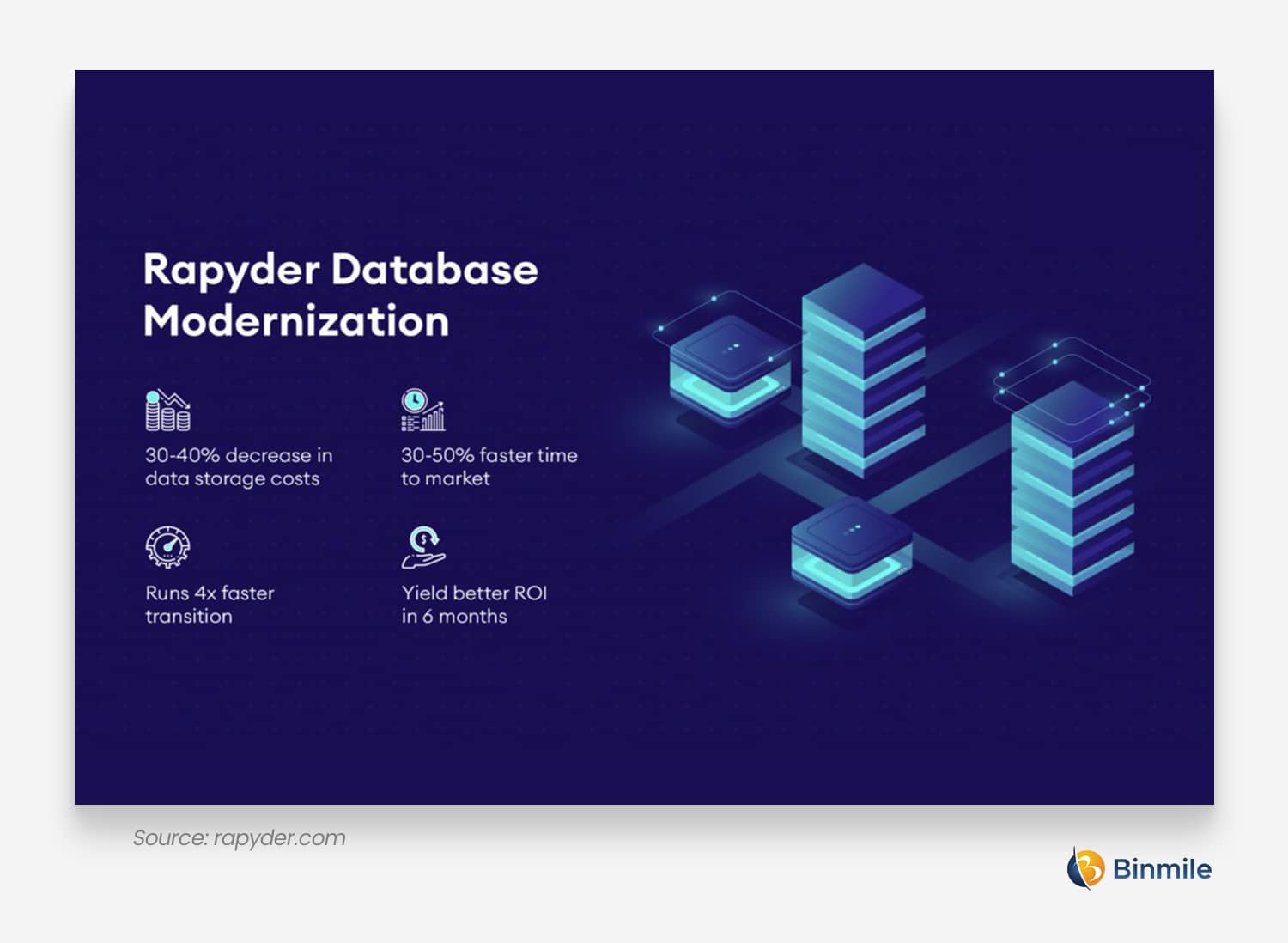
Since we’ve discussed what is data modernization services, it’s evident that we also discuss how to develop a data-first modernization strategy. Let’s explore a systematic approach to transforming your organization’s data practices with these 5 steps:
1: Assess Current State
Businesses should start by conducting a thorough assessment of their current data landscape. Identify existing data sources, systems, and processes. Understand data quality, accessibility, and integration challenges. This assessment will serve as a baseline for the modernization efforts and pave the path for a seamless and integrated shift to a data-first culture.
2: Define Business Objectives
Clearly outline the organization’s business objectives and goals. Understand how data can support these objectives. Without a clear end goal, your strategy cannot work and resources will be wasted. For instance, are you aiming to improve customer experiences, optimize operations, or drive innovation? Align your data strategy with these goals to ensure a focused approach.
3: Data Architecture Design
Design a data architecture that supports the business objectives. Determine whether a cloud-based solution, data lakes, or hybrid approaches best suit your needs. Consider factors like scalability, flexibility, and security. Plan how data will flow, be stored, integrated, and analyzed across systems to avoid any challenges in transition.
4: Select Modern Technologies
Choose technologies that align with your architecture and objectives. Select data platforms, analytics tools, and AI solutions that offer advanced capabilities such as real-time processing, predictive analytics, and machine learning. Ensure these tools can scale as your data needs grow and you don’t struggle with excessive costs-related issues.
5: Implementation and Iteration
Begin implementing your strategy in phases and start with a pilot project to test and validate your approach for assured success. As you apply the strategy, continuously monitor performance, gather feedback, and iterate. Doing so, not only refines your strategy based on insights and lessons but also ensures a smooth transition from legacy systems.
Final Thoughts
To sustain in a data-driven world, businesses must overcome digital transformation challenges and deliver on the promise of innovation. Data modernization services will enable them to revolutionize how they operate and to thrive in an era where data serves as a strategic asset driving growth and competitive advantage. Therefore, by adopting database modernization services the right way, businesses can transform the way they offer products and services and adapt smartly to evolving business requirements.
In this blog, we talked about how application modernization services can help businesses leverage the power of data, and share a solid strategy to develop a data-first culture. As one of the leading data modernization companies, we can help your organization optimize your data, enhance decision-making, and position your organization for success in the digital age.
Frequently Asked Questions
A Data Modernization Strategy is a comprehensive plan or approach adopted by organizations to upgrade and transform their data infrastructure, processes, and technologies to meet the evolving needs of the business in the digital age.
Data Modernization is important for organizations because it enables them to leverage the full potential of their data assets to drive innovation, improve decision-making, enhance operational efficiency, and maintain competitiveness in the market. By modernizing data infrastructure and practices, organizations can unlock valuable insights, respond to changing business demands, and adapt to technological advancements.
Data Modernization offers several benefits, including:
- Improved Data Quality: Modernizing data infrastructure and processes often involves implementing data quality management practices and tools, leading to enhanced data accuracy, consistency, and reliability.
- Increased Agility: Modernized data architectures enable organizations to adapt quickly to changing business needs and market dynamics, facilitating faster decision-making and innovation.
- Enhanced Scalability: Modern data platforms and cloud-based solutions offer scalability to handle growing volumes of data and support business growth without significant infrastructure investments.
- Better Insights: By integrating and analyzing data from disparate sources more efficiently, organizations can gain deeper insights into their operations, customers, and markets, enabling data-driven decision-making and competitive advantage.
- Cost Savings: Data Modernization can lead to cost savings through reduced maintenance costs, improved operational efficiency, and optimized resource utilization.
- Regulatory Compliance: Modern data management practices help organizations comply with data privacy regulations and security standards by implementing robust data governance, access controls, and audit trails.
- Enhanced Customer Experience: By leveraging data more effectively, organizations can personalize customer interactions, deliver targeted marketing campaigns, and provide better products and services, leading to improved customer satisfaction and loyalty.
Automated data modernization refers to the use of automated tools, processes, and technologies to streamline and accelerate the modernization of legacy data infrastructure, systems, and processes. It involves automating various tasks such as data migration, schema conversion, data cleansing, and transformation to modernize data architectures more efficiently and with minimal manual effort.
To begin the data modernization journey, organizations should:
- Assess Current Systems: Identify the limitations of existing data infrastructure.
- Set Clear Goals: Define what the business hopes to achieve through modernization, such as improving analytics, increasing security, or reducing costs.
- Choose the Right Tools and Techniques: Employ tools like Change Data Capture (CDC) techniques for smooth migration and integration of data.
- Collaborate with Experts: Partner with experienced data modernization service providers to ensure a smooth transition.
